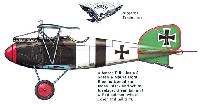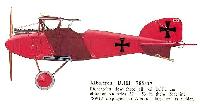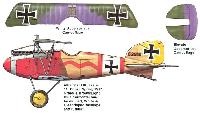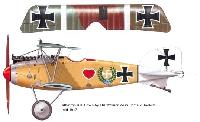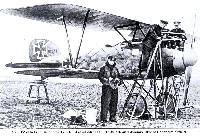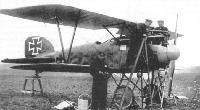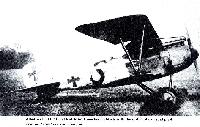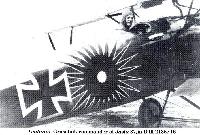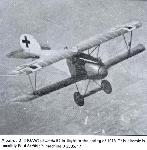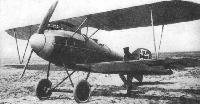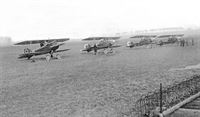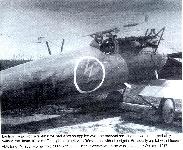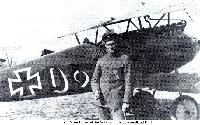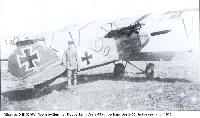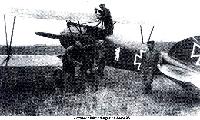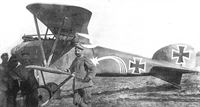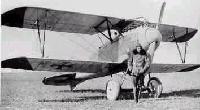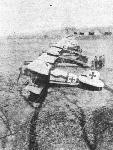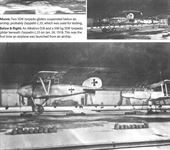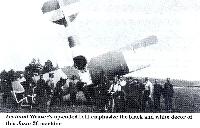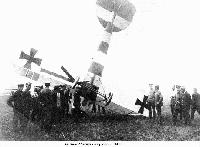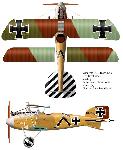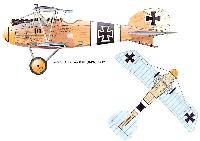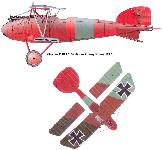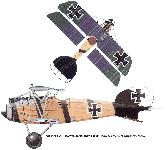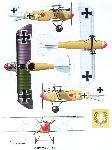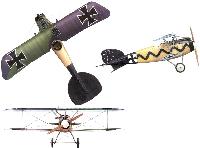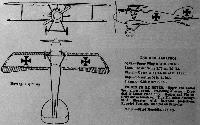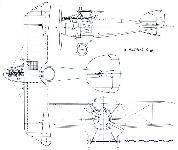
Описание
Страна: Германия
Год: 1916
Истребитель
Варианты
- Albatros - D.III - 1916 - Германия
- Albatros - C.XIII - 1917 - Германия
- Albatros - D.V/D.Va - 1917 - Германия
- Albatros - Dr.I - 1917 - Германия
- В.Кондратьев Самолеты первой мировой войны
- O.Thetford, P.Gray German Aircraft of the First World War (Putnam)
- W.Green, G.Swanborough The Complete Book of Fighters
- J.Herris Albatros Aircraft of WWI. Vol.4: Fighters (A Centennial Perspective on Great War Airplanes 27)
- Журнал Flight
-
В.Кондратьев - Самолеты первой мировой войны
"Альбатрос" D.III, пилот Эрнст Удет, январь 1917г.
-
J.Herris - Albatros Aircraft of WWI. Volume 4: Fighters /Centennial Perspective/ (27)
Albatros D.III D.1941/16 flown by Lt. Ernst Udet, Jasta 15, Habsheim Aerodrome, January 1917.
-
J.Herris - Albatros Aircraft of WWI. Volume 4: Fighters /Centennial Perspective/ (27)
Albatros D.III D.2005/16 of Jasta 21.
-
J.Herris - Albatros Aircraft of WWI. Volume 4: Fighters /Centennial Perspective/ (27)
Albatros D.III D.2006/16 flown by Lt. Lothar Freiherr von Richthofen of Jasta 11, La Brayelle Aerodrome, March-April 1917. Lothar inherited this aircraft from his older brother Manfred.
-
Сайт - Pilots-and-planes /WWW/
Albatros D.III flown by Ltn Lothar von Richthofen, Jasta 11, early 1917.
-
J.Herris - Albatros Aircraft of WWI. Volume 4: Fighters /Centennial Perspective/ (27)
Albatros D.III D.2049/16 flown by Oblt. Hermann Goring commanding Jasta 27 at Isegham Aerodrome, Summer 1917. Goring scored 22 victories and was awarded the Pour le Merite. He later became infamous as Reichsmarschall of the Third Reich.
-
J.Herris - Albatros Aircraft of WWI. Volume 4: Fighters /Centennial Perspective/ (27)
Albatros D.III D.2090/16 flown by Lt. Fritz Jacobsen of Jasta 31, April 1917. Jacobsen scored 8 victories and survived the war despite being shot down twice.
-
J.Herris - Albatros Aircraft of WWI. Volume 4: Fighters /Centennial Perspective/ (27)
Albatros D.III D.2090/16 flown by Lt. Fritz Jacobsen of Jasta 31, June 1917. This is the same aircraft shown above after Jacobsen painted it in a flower motif camouflage pattern.
-
J.Herris - Albatros Aircraft of WWI. Volume 4: Fighters /Centennial Perspective/ (27)
Albatros D.III D.2132/16 flown by Lt. Ernst Udet, Jasta 37, Moncheaux Aerodrome, June 1917.
-
J.Herris - Albatros Aircraft of WWI. Volume 4: Fighters /Centennial Perspective/ (27)
Albatros D.III D.2174/16 of Fl.Abt. 300 'Pasha' in Palestine. A second radiator has been installed by unit mechanics above the upper wing to provide additional cooling.
-
J.Herris - Albatros Aircraft of WWI. Volume 4: Fighters /Centennial Perspective/ (27)
Albatros D.III D.2182/16 flown by Oblt. Rudolf Berthold, Staffelfuhrer of Jasta 14, Marchais Aerodrome, Spring 1917. Berthold scored 44 victories and was awarded the Pour le Merite.
-
J.Herris - Albatros Aircraft of WWI. Volume 4: Fighters /Centennial Perspective/ (27)
Albatros D.III D.2219/16 flown by Lt. Gerhard Bassenge of Jasta Boelcke. Bassenge scored 7 victories and survived the war.
-
J.Herris - Albatros Aircraft of WWI. Volume 4: Fighters /Centennial Perspective/ (27)
Albatros D.III D.2244/16 flown by Lt. Heinrich Bussing of Jasta 5, July 1917. Bussing claimed six victories, two of which were confirmed, and was killed 10 May 1918 while testing an Albatros D.Va.
-
Сайт - Pilots-and-planes /WWW/
Albatros D.III Jasta 5. Green & Mauve/Light Blue horizontal surfaces. Black and White fuselage, Green tail unit & Red spinner, wheel cover and tail trim.
-
J.Herris - Albatros Aircraft of WWI. Volume 4: Fighters /Centennial Perspective/ (27)
Albatros D.III D.2274/16 flown by Oblt. Adolf Ritter von Tutschek commanding Jasta 12. The aircraft was overall black with white cross fields on the wings and tail. Tutschek scored 27 victories and was awarded the Pour le Merite before being KIA 15 March 1918.
-
J.Herris - Albatros Aircraft of WWI. Volume 4: Fighters /Centennial Perspective/ (27)
Albatros D.III D.636/16 (636/17 ???) of Fl.Abt. 300 'Pasha' in Palestine. A second, leading edge radiator has been installed in the field to provide additional cooling.
-
Сайт - Pilots-and-planes /WWW/
Albatros D.III D.774/17 flown by Oblt Otto Hartmann, leader of Jasta 28, 1917.
-
Сайт - Pilots-and-planes /WWW/
Albatros D.III 789/17. Richthofen flew three all red D.IIIs and obtained victories 37 - 53 in them/ Machine 789/17 displayed an Albatros logo on its rudder.
-
J.Herris - Albatros Aircraft of WWI. Volume 4: Fighters /Centennial Perspective/ (27)
Albatros D.III(OAW) D.1671/17 flown by Max Rosenkrantz of Kest 5.
-
Сайт - Pilots-and-planes /WWW/
Albatros D.III D.2090/17 flown by Vfw Fritz Jacobson, Jasta 31, April 1917.
-
J.Herris - Albatros Aircraft of WWI. Volume 4: Fighters /Centennial Perspective/ (27)
Albatros D.III(OAW) flown by Vzfw. Steinstrater of Jasta 50, who was credited with one victory.
-
Сайт - Pilots-and-planes /WWW/
Albatros D.III D.2385/17 flown by Ltn Paul Strahle, Staffelfuhrer of Jasta 57, spring 1918.
-
Сайт - Pilots-and-planes /WWW/
Albatros D.III Jasta 11, Douai, Spring 1917. Green & Brown/Light Blue horizontal surfaces. Red, White & Clear-doped fuselage and rudder.
-
J.Herris - Albatros Aircraft of WWI. Volume 4: Fighters /Centennial Perspective/ (27)
Albatros D.III(OAW) 3210/17 of Ltn.d.R. Werner Hafner of Jasta 57. Hafner was KIA in this aircraft on 13 March 1918.
-
J.Herris - Albatros Aircraft of WWI. Volume 4: Fighters /Centennial Perspective/ (27)
Albatros D.III(OAW) 3237/17 of an unknown unit in 1918 insignia photographed in Swiss hands. The colors of the nose, band, and shield are assumed.
-
J.Herris - Albatros Aircraft of WWI. Volume 4: Fighters /Centennial Perspective/ (27)
Albatros D.III(OAW) 3237/17 after the fuselage and tail were over-painted in Swiss markings. The wings retained their German markings. The colors of the nose, band, and shield are assumed.
-
В.Кондратьев - Самолеты первой мировой войны
Альбатрос D.III, пилот - лейтенант К.Альменродер, весна 1917г.
-
J.Herris - Development of German Warplanes in WWI /Centennial Perspective/ (1)
Albatros D.III flown by Lt. Hermann Frommherz of Jasta Boelcke. It was painted an overall light blue at the Jasta. The black and white markings were also added there. Frommherz became an ace with 32 victories and was nominated for the Pour le Merite, but the Kaiser abdicated before signing the award and Frommherz never received it.
-
J.Herris - Albatros Aircraft of WWI. Volume 4: Fighters /Centennial Perspective/ (27)
Albatros D.III flown by Lt. Josef Veltjens of Jasta 14, March-April 1917. The arrow was Veltjens' personal insignia. He survived the war with 35 victories and was awarded the Pour le Merite.
-
J.Herris - Albatros Aircraft of WWI. Volume 4: Fighters /Centennial Perspective/ (27)
Albatros D.III of Jasta 28, Varssenmaere Aerodrome.
-
J.Herris - Albatros Aircraft of WWI. Volume 4: Fighters /Centennial Perspective/ (27)
Albatros D.III of Jasta 28, Wasquehal Aerodrome. Jasta 28 had yellow horizontal tail surfaces with a black chord-wise stripe.
-
J.Herris - Albatros Aircraft of WWI. Volume 4: Fighters /Centennial Perspective/ (27)
Albatros D.III(OAW) flown by Off.stv. Wilhelm Kuhne of Kest 9, Sonsenheim Aerodrome. Kuhne later served with Jastas 15 and 18, scoring 7 victories before being KIA on 30 August 1918 while attacking DH.4s of 55 Squadron, Independent Air Force.
-
J.Herris - Albatros Aircraft of WWI. Volume 4: Fighters /Centennial Perspective/ (27)
Albatros D.III(OAW), pilot unknown, of Kest 9, Sonsenheim Aerodrome.
-
J.Herris - Albatros Aircraft of WWI. Volume 4: Fighters /Centennial Perspective/ (27)
Albatros D.III(OAW), pilot unknown, of Kest 9, Sonsenheim Aerodrome.
-
J.Herris - Albatros Aircraft of WWI. Volume 4: Fighters /Centennial Perspective/ (27)
Albatros D.III flown by Lt. Heinrich Schleth of Jasta 37.
-
J.Herris - Albatros Aircraft of WWI. Volume 4: Fighters /Centennial Perspective/ (27)
Albatros D.III of Jasta 18, Summer 1917. With its comet insignia, this is likely the aircraft of Oblt. Harald Auffarth, who scored 29 victories and was proposed for the Pour le Merits, but it was not approved by the Armistice.
-
J.Herris - Albatros Aircraft of WWI. Volume 4: Fighters /Centennial Perspective/ (27)
Albatros D.III flown by Off.stv. Franz Hilger, possibly at Jasta 27.
-
J.Herris - Albatros Aircraft of WWI. Volume 4: Fighters /Centennial Perspective/ (27)
Albatros D.III flown by Lt. Werner Voss of Jasta, June 1917. The aircraft is shown in its final configuration and markings before Voss started flying a Fokker Triplane. Voss was awarded the Pour le Merits and scored 48 victories before being KIA in an epic combat with 56 Squadron, RFC on 23 September 1917.
-
Сайт - Pilots-and-planes /WWW/
Albatros D.III flown by Ltn Werner Voss, Jasta 2 Boelcke, mid-1917.
-
J.Herris - Albatros Aircraft of WWI. Volume 4: Fighters /Centennial Perspective/ (27)
Albatros D.III flown by Lt. Friedrich Kempf of Jasta Boelcke. Kempf scored 4 victories and survived the war.
-
J.Herris - Albatros Aircraft of WWI. Volume 4: Fighters /Centennial Perspective/ (27)
Albatros D.III flown by Lt. Joachim von Bertrab of Jasta 30. Von Bertrab scored 5 victories before being shot down on 12 August 1917 by "Mick" Mannock and taken POW while attacking a balloon.
-
J.Herris - Albatros Aircraft of WWI. Volume 4: Fighters /Centennial Perspective/ (27)
Albatros D.III(OAW) flown by Oblt. Wilhelm Turck of Jasta 18. Turck scored 1 victory and commanded Jasta 54 from 18 May 1918 to the Armistice.
-
J.Herris - Albatros Aircraft of WWI. Volume 4: Fighters /Centennial Perspective/ (27)
Albatros D.III(OAW) flown by Oblt. Rudolf Berthold, Staffelfuhrer of Jasta 18, late 1917. Due to wounds he was removed from the front by order of the Kaiser.
-
В.Обухович, А.Никифоров - Самолеты Первой Мировой войны
Альбатрос D II
-
Сайт - Pilots-and-planes /WWW/
Albatros D.III flown by Ltn Franz Ray, Jasta 49, 1918.
-
Сайт - Pilots-and-planes /WWW/
Albatros D.III flown by Kurt Wusthoff, Jasta 4, summer 1917.
-
J.Herris - Albatros Aircraft of WWI. Volume 4: Fighters /Centennial Perspective/ (27)
Albatros D.III of Jasta 12. Black tails and white spinners were the Jasta 12 colors at this time. On most Jasta 12 aircraft the black tail did not stop in the middle of the national insignia.
-
J.Herris - Albatros Aircraft of WWI. Volume 4: Fighters /Centennial Perspective/ (27)
Albatros D.III(OAW) flown by Vzfw. Boldt of Jasta 31. The devil's head was his personal insignia.
-
J.Herris - Albatros Aircraft of WWI. Volume 4: Fighters /Centennial Perspective/ (27)
Albatros D.III(OAW) flown by Off.stv. Johann Dierle of Kest 4b, Freiburg Aerodrome. The colors are not known; above shows it painted with the green and mauve colors used on the wings, below shows it in green and brown.
-
J.Herris - Albatros Aircraft of WWI. Volume 4: Fighters /Centennial Perspective/ (27)
Albatros D.III(OAW) flown by Vzfw. Pinkert of Jasta 25 in Macedonia. Checkerboard colors are assumed.
-
J.Herris - Albatros Aircraft of WWI. Volume 4: Fighters /Centennial Perspective/ (27)
Albatros D.III(OAW) 1835/17 of the Polish Air Service, May 1919
-
J.Herris - Albatros Aircraft of WWI. Volume 4: Fighters /Centennial Perspective/ (27)
Albatros D.III(OAW) 2575/17 captured and flown by the Imperial Russian Air Service.
-
J.Herris - Albatros Aircraft of WWI. Volume 4: Fighters /Centennial Perspective/ (27)
Albatros D.III AKD3 of the Turkish Air Service, 1918.
-
J.Herris - Albatros Aircraft of WWI. Volume 4: Fighters /Centennial Perspective/ (27)
An unarmed Albatros D.III prototype.The D.III used the same fuselage and tail structure and the same 160 hp Mercedes D.III engine and two Spandau machine guns as the earlier D.I and D.II coupled with a new wing cellule inspired by the Nieuport. The new wing improved climb and maneuverability at the cost of structural weakness of the single-spar lower wing, something that had not been a problem with the earlier D.I/D.II wing design.
-
J.Herris - Albatros Aircraft of WWI. Volume 4: Fighters /Centennial Perspective/ (27)
Albatros D.III 1729/16 tactical number '13' of Jasta 21 with a dark and white band around the fuselage has an auxiliary strut between the leading edge of the lower wing and the forward interplane strut. The single-spar lower wing introduced on the D.III significantly weakened the wing cellule. The problem was not the static strength, which was tested and found to be sufficient, but the dynamic characteristics. The problem was flutter, a dynamic structural problem not understood at the time. During high speeds, and aggravated by high-G loading, the lower wing would twist around the single spar, and this twisting motion would quickly oscillate back and forth and could tear the lower wing off the aircraft, a catastrophic failure that was often fatal. The auxiliary strut was an attempt to strengthen the wing cellule against twisting and was an improvement but not a complete solution. The more streamlined D.V had an even weaker attachment of the lower wing spar to the fuselage and was even more susceptible to this problem.
-
J.Herris - Albatros Aircraft of WWI. Volume 4: Fighters /Centennial Perspective/ (27)
Albatros D.III D.1729/16 flown by Lt. Scheller of Jasta 19. Scheller was credited with four victories.
-
Сайт - Pilots-and-planes /WWW/
Udet stands in front of his Albatros D.III D.1941/16 on a freezing January morning in 1917.The mechanics are warming the engine with pre-warmed oil and hot water. Even so, the coolant could quickly freeze in such cold temperatures. Ironically, the Militaar Nummer, 1941/16, reflects the year Udet would later die.
-
В.Кондратьев - Самолеты первой мировой войны
Известный германский ас Эрнст Удет возле своего "Альбатроса" D.III.
-
J.Herris - Albatros Aircraft of WWI. Volume 4: Fighters /Centennial Perspective/ (27)
Albatros D.III D.1996/16 flown by Lt. Rudolf Hohberg of FliegerAbteilung (A) 263.This D.III had been fitted with an automatic strip camera for photo-reconnaissance. The underside was painted a light color, probably light blue, apparently to reduce detection from the ground. The fin appears to be patched.
-
J.Herris - Albatros Aircraft of WWI. Volume 4: Fighters /Centennial Perspective/ (27)
Albatros D.III 1997/16 of Jasta 19. The pilot is Lt Reinhold Oertelt, who was shot down and killed by French ace Georges Guynemer on July 7,1917 for his 47th victory.This was the last photo of Oertelt before his death in action.
-
J.Herris - Albatros Aircraft of WWI. Volume 4: Fighters /Centennial Perspective/ (27)
Albatros D.III of Offz.Stv. Julius Buckler, Jasta 17, possibly D.2033/16. The 'V-struts' of the D.III were a prominent identification feature. Buckler was a very successful fighter pilot, scoring 35 or 36 victories and surviving the war despite having earned the Golden Wound Badge for being wounded five times in battle. He reached the rank of Leutnant, became Staffelfuhrer of Jasta 17, and was awarded the Pour le Merite after achieving 30 victories.
-
J.Herris - Albatros Aircraft of WWI. Volume 4: Fighters /Centennial Perspective/ (27)
Top: Albatros D.III 2051/16 in the middle and Rumpler C.I C.4633/15 at left. In the right background is the Albatros D.I fighter with skull and cross-bones insignia often flown by Prinz Friedrich Karl von Preussen, crown prince of Prussia.
Bottom: Manfred von Richthofen walks toward the photographer with a Albatros D.III 2051/16 behind him and Rumpler C.I C.4633/15 at left. In the right background is the Albatros D.I fighter with skull and cross-bones insignia often flown by Prinz Friedrich Karl von Preussen, crown prince of Prussia.Другие самолёты на фотографии: Albatros D.I/D.II - Германия - 1916Rumpler C.I/C.Ia - Германия - 1914
-
J.Herris - Albatros Aircraft of WWI. Volume 4: Fighters /Centennial Perspective/ (27)
Albatros D.III 2052/16 flown by Lt. Hans von Budde of Jasta 29; his individual marking was the initial of his last name.
-
J.Herris - Albatros Aircraft of WWI. Volume 4: Fighters /Centennial Perspective/ (27)
The starboard and port sides of Albatros D.III 2062/16 are captured in these images, which were taken soon after Lt. Emil Schaefer's emergency landing on 9 March 1917.
-
J.Herris - Albatros Aircraft of WWI. Volume 4: Fighters /Centennial Perspective/ (27)
Albatros D.III D.2090/16 flown by Lt. Fritz Jacobsen of Jasta 31 (at right). The large windscreen is unusual, as is the plate over the machine gun mechanism.
-
J.Herris - Albatros Aircraft of WWI. Volume 4: Fighters /Centennial Perspective/ (27)
Albatros D.III D.2096/16 Vera after capture by the French. Vera was flown by Lt. Friedrich-Wilhelm Wichard of Jasta 24 and was brought down on 21 April 1917. This aircraft was subsequently shipped to the US and this photo of the aircraft on the takeoff run was possibly taken at McCook Field in the US.
-
H.Cowin - Aviation Pioneers /Osprey/
Lt Hans Adam of Bavarian Jasta 35, seen in the cockpit of his Albatros D III, 2101/16. Adam, with 21 confirmed 'kills', met his own end in the skies over Mortvilde on 15 November 1917, while flying with Bavarian Jasta 6.
-
J.Herris - Albatros Aircraft of WWI. Volume 4: Fighters /Centennial Perspective/ (27)
Albatros D.III 2119/16 of Otto Bernert when he visited the Jastaschule near Valenciennes. Bernert was commanding Jasta Boelcke at the time. Bernert scored 27 victories and was awarded the Pour le Merite. After recovering from a crash, he died of the worldwide influenza epidemic on 19 October 1918.
-
Сайт - Pilots-and-planes /WWW/
Albatros D.III D.2125/16 of Jasta 1 marked in black with the initial of its usual pilot, Leutnant Freiherr von Stenglin.
-
Сайт - Pilots-and-planes /WWW/
Leutnant Grasshof, commander of Jasta 37, in Albatros D.III D.2135/16
-
J.Herris - Albatros Aircraft of WWI. Volume 4: Fighters /Centennial Perspective/ (27)
Albatros D.III D.2140/16 flown by Lt Paul Erbguth of Jasta 30. His personal markings include his initial in red and a white rudder with black outline.
-
J.Herris - Albatros Aircraft of WWI. Volume 4: Fighters /Centennial Perspective/ (27)
Albatros D.III D.636/17, (left) and 2174/16 (right) of Flieger-Abteilung 300 Pascha were standard D.IIIs fitted with single airfoil radiators when they were shipped to Palestine. The cooling properties of the standard single radiator setup left much to be desired in the desert heat. The ad hoc solutions of the mechanics to resolve these problems are seen here in both of these aircraft.
-
J.Herris - Albatros Aircraft of WWI. Volume 4: Fighters /Centennial Perspective/ (27)
Closeup of Albatros D.III 2174/16 showing an ad hoc double-decker radiator installation. Because of these cooling difficulties and the resultant feedback from the pilots and mechanics, the next series of D.III aircraft they received would be fitted with twin radiators and required plumbing. It is a tribute to the creativity of the mechanics and ground crew of these units who worked so hard to find solutions to keep the aircraft in the air.
-
J.Herris - Albatros Aircraft of WWI. Volume 4: Fighters /Centennial Perspective/ (27)
Rudolf Berthold's Albatros D.III 2182/16 at Jasta 14's Marchais airfield. Berthold's personal insignia, a white winged sword, has been painted on its natural wood fuselage.
-
J.Herris - Albatros Aircraft of WWI. Volume 4: Fighters /Centennial Perspective/ (27)
Albatros D.III 2219/16 flown by Lt. Gerhard Bassenge in Jasta Boelcke. Bassenge was an ace who was credited with 7 victories and survived the war.
-
J.Herris - Albatros Aircraft of WWI. Volume 4: Fighters /Centennial Perspective/ (27)
Albatros D.III 2219/16 flown by Lt. Gerhard Bassenge in Jasta Boelcke photographed with Lt. Franz Pernet. Pernet, who was Ludendorff's stepson, was killed in action on 5 September 1917 without having scored any victories.
-
A.Imrie - German Naval Air Service /Arms & Armour/
Flugmaat Franz Wangemann of the Marinefeldjagdstaffel with his Albatros D III, D2288/16, at Aertrycke aerodrome in April 1917. This unit, under Leutnant zur See Sachsenberg, operated with success in the area of the Fourth German Army occupied by the Marine Corps. As aerial fighting activity increased, the Staffel was joined by other naval landplane fighter units until, towards the end of 1918, the five Marinefeldjagdstaffeln were formed into the Marinefeldjagdgeschwader under Sachsenberg. It had a strength of over 50 fighters.
-
J.Herris - Albatros Aircraft of WWI. Volume 4: Fighters /Centennial Perspective/ (27)
Bottom: Lt. Kurt Wolff poses in front of D.III 632/17 after it had been painted "bright red with grass green tail control surfaces." Wolff scored 33 victories and was awarded the Pour le Merite. He was KIA on 15 September 1917 while flying Manfred von Richthofen's Fokker F.I 102/17.
-
J.Herris - Albatros Aircraft of WWI. Volume 4: Fighters /Centennial Perspective/ (27)
Albatros D.III D.636/17, shown serving with FliegerAbteilung 300 Pascha prior to capture, was a standard D.III and shows why the twin radiator solution was needed. The inadequate cooling of the standard radiator setup is demonstrated here by the ad hoc addition of a box-type radiator, commonly used on two-seater aircraft, fitted above the wing.
-
M.Dusing - German Aviation Industry in WWI. Volume 1 /Centennial Perspective/ (84)
D.III D.636/17, which served with FliegerAbteilung 300 Pascha, is shown here after being captured in the Middle East. The wheels are replacements from a British aircraft; the originals were damaged in towing it back to the British squadron. The additional over-wing radiator, visible in the photo before capture, has been removed.
-
J.Herris - Albatros Aircraft of WWI. Volume 4: Fighters /Centennial Perspective/ (27)
Albatros D.III D.767/17 was from the last production batch ordered from the main Albatros factory in March 1917; it is shown here in plain factory finish before any personal markings were applied. Lt. Oskar Seitz of Jasta 30 sits in the cockpit.
-
J.Herris - Albatros Aircraft of WWI. Volume 4: Fighters /Centennial Perspective/ (27)
Albatros D.III D.767/17 after Lt. Seitz's personal markings were applied. Those markings included his red initial for his last name and the blue and white Bavarian rauten (lozenge) colors on the vertical tail.
-
J.Herris - Albatros Aircraft of WWI. Volume 4: Fighters /Centennial Perspective/ (27)
Albatros D.III(OAW) 1671/17 of Kest 5 wears striking markings. The pilot was Max Rosenkrantz.
-
M.Dusing - German Aviation Industry in WWI. Volume 1 /Centennial Perspective/ (84)
Albatros D.III with ground crew in front of an airship hangar.
-
J.Herris - Albatros Aircraft of WWI. Volume 4: Fighters /Centennial Perspective/ (27)
Here is an impressive lineup of Albatros D.III(OAW) fighters serving with Jasta 50; the rounded D.V rudders are characteristic of late D.III production aircraft. The Staffel marking was the dark/white chevrons on the horizontal tail surfaces. The dark color is thought to be dark red. The very first in line, D.2362/17 with the dark/white chevron marking on its fuselage, was flown by Uffz. Fritz Liese. The next, D.2377/17 with the dark/white zig-zag fuselage marking, was flown by Vzfw. Wittenfeld. Fourth in line, D.2368/17, with the dark/white triangular pennant on its fuselage, was the machine of Lt. Buddeberg. Fifth in line, D.2384/17 with the vertical dark/white stripes in the proportions of the Iron Cross ribbon, was flown by Lt. Glocklen. Staffelfuhrer Lt. Heinrich Arntzen flew D.2380/17, which is ninth in line and was marked with the German observer's badge.
-
Сайт - Pilots-and-planes /WWW/
Albatros D.III(OAW) of Jasta 57 in flight in the spring of 1918. This aircraft is possibly Paul Strahle's machine D.2385/17.
-
K.Delve - World War One in the Air /Crowood/
This angle clearly shows the upper wing cut-out on this Albatros DIII to improve the pilot's forward and upward view and the smooth, semi-monocoque plywood fuselage.
-
J.Herris - Albatros Aircraft of WWI. Volume 4: Fighters /Centennial Perspective/ (27)
Lt. Hermann Habich poses with elegantly-marked Albatros D.III (OAW) 5129/17 of Jasta 49.
-
J.Herris - Albatros Aircraft of WWI. Volume 4: Fighters /Centennial Perspective/ (27)
Albatros D.III photographed at the Fokker works. There are multiple views, indicating that Fokker was very interested in what his competitors were doing.
-
J.Herris - Albatros Aircraft of WWI. Volume 4: Fighters /Centennial Perspective/ (27)
An Albatros D.III of Jasta 20 that force-landed in Holland is the center of attention for the local Dutch citizenry.
-
K.Delve - World War One in the Air /Crowood/
An Albatros DIII in Palestine. The Germans provided air assets to support the Turks in various areas, but the level of air involvement was generally small.
-
H.Cowin - Aviation Pioneers /Osprey/
The Albatros D III, although having an entirely new wing, elsewhere embodied as much of the D II componentry as it could, revealing that Albatros's Chief Engineer, Robert Thelen's design philosophy lent towards doing things in an evolutionary, rather than a revolutionary manner. The D III can with hindsight be seen as the best of the Albatros single seaters, its successor, the D V incorporating too few real improvements over the D III at a time when the opposition was advancing apace. The D III, great aeroplane as it turned out, had one major inherent design flaw that led to wing flutter at high speed and consequent occasional structural failure and mid-air break up. The root of the problem lay in Thelen's decision to follow the Nieuport practice by adopting a sesquiplane, literally a one and a half wing layout. In doing this.Thelen fell into the same trap that the Nieuports had already experienced and had never really solved. In essence, the trouble lay with the combination of a torsionally weak, small lower wing being made to twist and oscillate through then little understood aerodynamic loads transmitted to it via the 'V' type interplane struts. This led to D III pilots being prohibited from diving the machine above a certain speed; quite a constraint for pilots who at some time or another were going to rely on the aircraft's ability to break away quickly from combat with a superior opponent. Shown here is an initial production model Albatros D III, delivered to Jasta 29 in early 1917. Although very kind in terms of pilot handling, these early D IIIs, besides being dive limited had another hazard in the form of the radiator that can just be seen positioned immediately ahead of the cockpit and filling the space between fuselage and upper wing centre section. If hit during combat, the radiator fluid could readily scald the pilot and frequently did. The solution was to move it to the underside of the upper starboard wing. In all, more than 1,300 D IIIs were built, the first being delivered to the front in January 1917. While the sea level top speed of the D III was the same as that for the D I and D II, its speed at height was improved through the use of a high compression Daimler D III. Armament comprised the by-now standard twin 7.92mm Spandaus. The D III's heyday in the spring of 1917 began to fade by the summer when encountering the new Allied fighters in the shape of Sopwith Camels, Royal Aircraft Factory SE 5s and Spads.
-
В.Кондратьев - Самолеты первой мировой войны
"Альбатрос" D.III немецкого аса Карла Альменродера.
-
J.Herris - Albatros Aircraft of WWI. Volume 4: Fighters /Centennial Perspective/ (27)
Albatros D.III under test mounting an airspeed indicator on the left interplane strut.
-
W.Green, G.Swanborough - The Complete Book of Fighters
An early ex-works Albatros D III with the original centrally-located radiator.
By November 1917 there were well over 400 Albatros DIIIs in front-line service, although by the summer the types had been technologically superseded by the DV. -
M.Dusing - German Aviation Industry in WWI. Volume 2 /Centennial Perspective/ (85)
Albatros D.III powered by 160 hp Mercedes D.III engine and "Wotan" propeller.
An extremely rare image, taken sometime after 15 April 1918, showing an Albatros D III fitted with additional small, load-spreading ancillary struts at the lower end of the normal 'V' interplane struts, clearly aimed at alleviating the high speed flutter problem. As these added struts have never appeared in any other picture of an Albatros D III seen by the author, he suspects that this fit was a locally devised modification. -
J.Herris - Albatros Aircraft of WWI. Volume 4: Fighters /Centennial Perspective/ (27)
This front view of an Albatros D.III shows its clean lines and attention to streamlining. The propeller was made by Axial as indicated by the Axial decals.
-
В.Кондратьев - Самолеты первой мировой войны
Albatros D III, fitted with D Va type rudder.
-
M.Dusing - German Aviation Industry in WWI. Volume 2 /Centennial Perspective/ (85)
Albatros D.III with Axial propeller.
-
H.Cowin - Aviation Pioneers /Osprey/
This early production Albatros D III of Lt Dornheim, Jasta 29, having its radiator put under scrutiny. This image is also useful in showing the standard starboard side-only position of the Mercedes D III's exhaust manifold.
-
J.Herris - Albatros Aircraft of WWI. Volume 4: Fighters /Centennial Perspective/ (27)
Albatros D.III of Jasta 14 marked with an outlined bar.
-
J.Herris - Albatros Aircraft of WWI. Volume 4: Fighters /Centennial Perspective/ (27)
Albatros D.III fighter-trainers of Jastaschule I at Valenciennes lined up for flight. The shiny dark (red?) Albatros D.III of commanding officer Hptm. Martin Zander, marked with the letter "Z" under the lower wing surfaces, is at far left. Mudguards were fitted to protect the propeller from debris.
-
J.Herris - Albatros Aircraft of WWI. Volume 4: Fighters /Centennial Perspective/ (27)
Hptm. Martin Zander, Fuhrer of Jastaschule I at Valenciennes, flew this shiny dark (red?) Albatros D.III marked with the letter "Z" under the lower wing surfaces. Mudguards were fitted to protect the propeller from debris.
-
J.Herris - Albatros Aircraft of WWI. Volume 4: Fighters /Centennial Perspective/ (27)
Albatros D.III warming up for take-off.
-
R.Kosin - The German Fighter since 1915 /Putnam/
Albatros D.III
-
J.Herris - Albatros Aircraft of WWI. Volume 4: Fighters /Centennial Perspective/ (27)
The hot climate of the Middle East required addition of a second radiator as shown in these photos of Albatros D.III(OAW) fighters serving there with FliegerAbteilung 300. At bottom is Lt. Emil Meinecke, who was credited with six victories in this remote theater.
-
D.Mechin - Oriental Adventures of the French Air force 1914-1918 /Aeronaut/
Albatros D.III captured on the Orient Front by Serbian troops after the final offensive. (Coll. Boris Ciglic)
-
Z.Czirok - German Aircraft in Hungarian Service /Centennial Perspective/ (92)
Albatros D.III captured on the Orient Front by Serbian troops after the final offensive.
German Albatros D.III captured at Krivolak rail station on 21st September 1918. (Boris Ciglic) -
J.Herris - Weird Wings of WWI /Centennial Perspective/ (70)
The German Heinecke parachute under testing and in use.
-
J.Herris - Albatros Aircraft of WWI. Volume 4: Fighters /Centennial Perspective/ (27)
Albatros D.III of a Marine Feld Jasta in striking markings.
-
J.Herris - Albatros Aircraft of WWI. Volume 4: Fighters /Centennial Perspective/ (27)
Jasta 12 adopted black as a unit color following the death of Hptm. Osteroth upon the arrival of Hptm. von Tutschek. Rosenfeld is seen with his now black painted Albatros D.III.
-
В.Кондратьев - Самолеты первой мировой войны
Лейтенант Генрих Бюссинг со своей матерью возле "Альбатроса" D.III.
-
J.Herris - Albatros Aircraft of WWI. Volume 4: Fighters /Centennial Perspective/ (27)
View of a colorful Albatros D.III(OAW) of Kest 5 carrying an elaborate dragon marking on both sides of its fuselage.
-
J.Herris - Albatros Aircraft of WWI. Volume 4: Fighters /Centennial Perspective/ (27)
Albatros D.III(OAW) flown by Vzfw. Boldt of Jasta 31 wears a striking marking.The devil's head was red, but the horns look to be a lighter color like yellow.
-
J.Herris - Albatros Aircraft of WWI. Volume 4: Fighters /Centennial Perspective/ (27)
Albatros D.III(OAW) flown by Vzfw. Boldt of Jasta 31 wears a striking marking.The devil's head was red, but the horns look to be a lighter color like yellow.
-
J.Herris - Albatros Aircraft of WWI. Volume 4: Fighters /Centennial Perspective/ (27)
Lt. Hans Henkel in his Albatros D.III 2022/16 of Jasta 19. Like other pilots of Jasta 19 Henkel's personal marking was the initial of his last name. Henkel had an interesting career as a fighter pilot in Palestine, including flying the only Pfalz Eindecker used in Palestine, before transferring to Jasta 19.
-
Сайт - Pilots-and-planes /WWW/
Leutnant Max Romer's Albatros had a wash applied over the national markings. It was most probably yellow, the Jasta 10 color. The lightning bolt was Romer's individual insignia. Previously a pilot with Flieger-Abteilung (A) 208, Romer had been with JG I just four weeks when he was killed on 2 October 1917.
-
M.Dusing - German Aviation Industry in WWI. Volume 1 /Centennial Perspective/ (84)
Alb D.III (Oaw) (1916).
-
Сайт - Pilots-and-planes /WWW/
Albatros D.III of Jasta 19 in the spring of 1917; the pilot is Lt.d.R. Franz Dotzel. Jasta 19 used personal insignias based on the pilot's last name with the letters in black and white.
-
Сайт - Pilots-and-planes /WWW/
Albatros D.III(OAW) flown by Gunther Dobberke in Jasta 45 (or perhaps Jasta 60) in the spring of 1918.
-
J.Herris - Albatros Aircraft of WWI. Volume 4: Fighters /Centennial Perspective/ (27)
Voss and his Albatros D.III are photographed together at Cologne's airfield. The aircraft has the final markings, including the heart on the fuselage turtledeck behind the cockpit and the white stripes on top of the upper wing.
-
J.Herris - Albatros Aircraft of WWI. Volume 4: Fighters /Centennial Perspective/ (27)
Voss' Albatros D.III at Egelsberg field outside of Krefeld. The photo appears to have been taken during Voss' Pour le Merite home leave in April 1917. Here Voss is in the cockpit and warming up the engine for takeoff. The aircraft did not yet have an outlined heart on the "turtledeck" aft of the cockpit, nor did it have white stripes on its upper wing. In addition, the radiator was center mounted in the upper wing.
-
H.Cowin - Aviation Pioneers /Osprey/
Werner Voss, born 13 April 1897, was not yet eighteen when he enlisted in a Hussars Regiment just prior to the outbreak of World War I. In August 1915, he transferred into flying, initially as an observer, where he survived the Battle of the Somme, launched on 1 July 1916 and a period when the Allies held superiority in the air. Voss left the front in August 1916 to be trained as a pilot, joining Jasta 2 on 21 November 1916, flying Albatros D IIIs. Six days later Voss scored his first 'kill'. By the end of February 1917, Voss's score was 22 and on 8 April 1917 he was awarded the Pour Le Merite. Voss went on to join Jasta 5, where he added a further 12 "kills' flying against the French, before taking command of Jasta 10 on 31 July 1917. Here, facing the British, Voss added another 14 victories, taking his total tally to 48 before he elected to fly just one more sortie prior to going on leave with his two brothers. Voss had the misfortune to encounter the hand-picked SE 5a pilots of No 56 Squadron, RAF and succumbed to their guns. Voss was the 4th ranking German air ace of the war. He is seen standing beside his Albatros D III of Jasta 2, decorated with his personal emblem.
-
J.Herris - Albatros Aircraft of WWI. Volume 4: Fighters /Centennial Perspective/ (27)
Voss and Manfred von Richthofen in conversation in mid-June 1917. Voss' mother is at far right. This photo shows that Voss's aircraft now has the heart insignia on the fuselage turtledeck and has the white over-wing stripes on the top of the upper wing. In addition, it now has its radiator off-set to the right. Either the radiator was moved or a new upper wing was fitted.
-
O.Thetford, P.Gray - German Aircraft of the First World War /Putnam/
Albatros D III flown by Werner Voss in Jasta 5.
-
J.Herris - Albatros Aircraft of WWI. Volume 4: Fighters /Centennial Perspective/ (27)
Albatros D.III(OAW) of Kest 9 flown by Off-stv. Wilhelm Kuhne (center). Kuhne later flew in Jasta 15 and Jasta 18, scoring 7 victories before his death in action on 30 August 1918 while attacking DH.4s of 55 Squadron, Independent Air Force.
-
J.Herris - Albatros Aircraft of WWI. Volume 4: Fighters /Centennial Perspective/ (27)
Albatros D.III(OAW) fighters of Kest 9. The photo above was taken at Sonsenheim Airfield. Unfortunately, the pilots are not identifed.
-
Сайт - Pilots-and-planes /WWW/
Leutnant Barenfanger of Jasta 28
-
J.Herris - Albatros Aircraft of WWI. Volume 4: Fighters /Centennial Perspective/ (27)
Joachim von Bertrab poses with his black-painted early D.III with white crosses.
-
J.Herris - Albatros Aircraft of WWI. Volume 4: Fighters /Centennial Perspective/ (27)
This photo was taken by the Bufa during their visit to Leffincourt and some of the pilots in the film are shown here in posed portraits taken by Bufa photographers for distribution to card manufacturers or newspapers.
Staffelfuhrer Oblt. Kurt Student in his Albatros D.III.
Kurt Student, like Boelcke and Immelmann, first came to the attention of his superiors thanks to his prowess flying a Fokker E III. Transferred with their E IIIs to the Russian Front in September 1915, Student and his companion soon found themselves unopposed whenever and wherever they flew. Later, Lt Student was to take command of Jasta 9 in 1917, staying as its leader until the Armistice, by which time he held the rank of Oberleutnant, or 1st lieutenant and had a confirmed score of 5 'kills'. Student went on to command the German airborne forces in World War II, a responsibility vested in the German air force, unlike its American and British opponents, whose armies retained full control of both glider and paratroop assets. Student is depicted here sitting in his Albatros D III soon after taking over Jasta 9. -
J.Herris - Albatros Aircraft of WWI. Volume 4: Fighters /Centennial Perspective/ (27)
The red eagle marking with light yellow/orange highlights was derived from a Fokker weapons advertisement.
-
J.Herris - Albatros Aircraft of WWI. Volume 4: Fighters /Centennial Perspective/ (27)
Albatros D.III with bar marking flown by Lt. Heinrich Schleth in Jasta 37.
-
Сайт - Pilots-and-planes /WWW/
OAW-built D.III of Leutnant Otto Fuchs with the pilot's personal emblem of the fox (Fuchs) chasing the Gallic cock.
-
J.Herris - Albatros Aircraft of WWI. Volume 4: Fighters /Centennial Perspective/ (27)
Lt. Harald Auffahrt often used a comet marking as his insignia. Was this one of his aircraft?
-
J.Herris - Albatros Aircraft of WWI. Volume 4: Fighters /Centennial Perspective/ (27)
Hptm. Franz Walz wrestles with a Syrian bear in front of a nagel neu (factory fresh) twin-radiator Albatros D.III(OAW). Walz became the leader of FliegerAbteilung 304b and was awarded the Pour le Merite during his service there.
-
J.Herris - Albatros Aircraft of WWI. Volume 4: Fighters /Centennial Perspective/ (27)
View of a colorful Albatros D.III(OAW) of Kest 5 carrying an elaborate dragon marking on both sides of its fuselage.
-
M.Dusing - German Aviation Industry in WWI. Volume 2 /Centennial Perspective/ (85)
This image of Offstv Edmund Nathanael, standing with his Albatros D III of Jasta 5, helps point up the fact that non-commissioned ranks formed a significant part of the total flying personnel strength, although perhaps less so in fighter units than elsewhere. Nathanael had scored 14 confirmed before being killed near Bourlon on 17 May 1917.
Edmund Nathanael in front of his Albatros D.III at Boistrancourt in March 1917 equipped with an Axial propeller. Edmund Nathanael was Jewish. -
J.Herris - Albatros Aircraft of WWI. Volume 4: Fighters /Centennial Perspective/ (27)
The hot climate of the Middle East required addition of a second radiator as shown in these photos of Albatros D.III(OAW) fighters serving there with FliegerAbteilung 300.
-
J.Herris - Albatros Aircraft of WWI. Volume 4: Fighters /Centennial Perspective/ (27)
Photos of the same Albatros D.III flown by Jasta 28 from Wasquehal airfield. The men are not pilots.
-
D.Mechin - Oriental Adventures of the French Air force 1914-1918 /Aeronaut/
In front of his Albatros D.III, Gerhard Fieseler of Jasta 25, top ace of German aviation in the Orient front, winner of 19 victories mostly confirmed by French archives... A one-man airforce.
-
J.Herris - Albatros Aircraft of WWI. Volume 4: Fighters /Centennial Perspective/ (27)
Uffz. Otto Rosenfeld of Jasta 12 is seen with a newly delivered Albatros D.III.
-
J.Herris - Albatros Aircraft of WWI. Volume 4: Fighters /Centennial Perspective/ (27)
Colorized version of a well-known photograph of Albatros D.III fighters of Jastas 4 and 11 at Roucourt airfield. The second aircraft was the all-red "Le Petit Rouge" flown by Manfred von Richthofen.
-
Журнал - Flight за 1917 г.
A Fighting Squadron, under the command of Von Richthofen ready for starting on its work.
-
J.Herris - Albatros Aircraft of WWI. Volume 4: Fighters /Centennial Perspective/ (27)
Albatros D.III fighters of Jasta 30. The closest aircraft was flown by Oblt. Hans Bethge, the commanding officer. Berlin native Bethge was an excellent fighter pilot and leader who scored 20 victories before being killed in action on 17 March 1918. Bethge had been nominated for the Pour le Merite but it had not been approved before his death.
-
J.Herris - Albatros Aircraft of WWI. Volume 4: Fighters /Centennial Perspective/ (27)
Much is read in Allied combat reports and crew accounts of encountering German fighters with dazzling paint schemes with checkered or striped finishes. This lineup of Jasta 36 fighters seen below gives ample evidence of that.
-
J.Herris - Albatros Aircraft of WWI. Volume 4: Fighters /Centennial Perspective/ (27)
Richthofen's red "Le Petit Rouge" is seen in a rare view taken at Lechelle in March-April 1917. Though marred, this photo reveals rare details not seen in other views, namely that the top wing was over-painted with a thin coating of red dope subduing the white cross surrounds while the upper surfaces of the lower wings appear in the normal two or three tone factory finish. Edy Lubbert's half yellow/half blue D.III appears in the lineup second from the right.
-
J.Herris - Albatros Aircraft of WWI. Volume 4: Fighters /Centennial Perspective/ (27)
Jasta 15's aircraft lined up behind their leader's. From right to left: Heinrich Gontermann and his D.V, Lt. Hans Hermann von Budde (wearing his distinctive Kurassier tunic and white-crowned service cap) and his D.V, Lt. Kurt Monnington and his D.V, Vzfw. Albert Haussmann and his D.V, and two Albatros D.IIIs. Heinrich Gontermann scored 39 victories and was awarded the Pour le Merite. Unfortunately, he died from injuries suffered when the wings of Fokker Dr.I 115/17 he was flying failed in flight and the aircraft crashed on 29 October 1917.
-
J.Herris - Albatros Aircraft of WWI. Volume 4: Fighters /Centennial Perspective/ (27)
Jasta 1F (aka Jasta 55) lineup of five Albatros fighters, three D.Vs and two D.III(OAW) at Djenin, Palestine in Spring 1918. A wide variety of personal markings are displayed on the aircraft.
Другие самолёты на фотографии: Albatros D.V/D.Va - Германия - 1917
-
J.Herris - Albatros Aircraft of WWI. Volume 4: Fighters /Centennial Perspective/ (27)
Jasta lineup with Albatros D.Va D.5309/17 at right. Two late-production Albatros D.III fighters are at middle and left.
Другие самолёты на фотографии: Albatros D.V/D.Va - Германия - 1917
-
J.Herris - Roland Aircraft of WWI /Centennial Perspective/ (9)
Roland D.II Edith and Albatros D.III fighters of Jasta 15.
Другие самолёты на фотографии: LFG Roland D.II - Германия - 1916
-
J.Herris - Albatros Aircraft of WWI. Volume 4: Fighters /Centennial Perspective/ (27)
Albatros D.III fighters of Jasta 12.
-
J.Herris - Albatros Aircraft of WWI. Volume 4: Fighters /Centennial Perspective/ (27)
Lineup of the Albatros D.III and D.V aircraft of Jasta 5, one of the most successful German fighter units. The green tails with red borders together with red spinners were the unit markings; each pilot then decorated his aircraft individually so it could be identified during combat.
Другие самолёты на фотографии: Albatros D.V/D.Va - Германия - 1917
-
J.Herris - Albatros Aircraft of WWI. Volume 4: Fighters /Centennial Perspective/ (27)
Beautifully decorated and maintained Albatros D.III fighters serving with Kest 1b.
-
J.Herris, J.Leckscheid - Fokker Aircraft of WWI. Vol.3: Early Biplane Fighters /Centennial Perspective/ (53)
The equipment of Kest 4b was progressively upgraded, and by 1 June 1917, the first Roland D.II arrived. Six of these aircraft replaced the oldest fighters and took center stage here, and when this photo was taken around July or August, only three Fokker D.III remained with the unit. Seen from right to left are: Fokker D.III 1583/16 Max, 1593/16, and 1638/16. The "Iron Cross" wheel cover marking was not carried over to the Roland and Albatros fighters. Three Albatros D.III complete the distant end of the lineup, which shows the opposite direction of the airfield at Freiburg. By 1 September, the last of the Fokker single-seaters had been given up by the unit.
Другие самолёты на фотографии: Fokker D.III / M.19 - Германия - 1916LFG Roland D.II - Германия - 1916
-
Сайт - Pilots-and-planes /WWW/
Jasta 27 lineup; a single Roland D.II is at left in a lineup consisting mostly of Albatros D.III and D.V fighters.
Другие самолёты на фотографии: Albatros D.V/D.Va - Германия - 1917LFG Roland D.II - Германия - 1916
-
J.Herris - Albatros Aircraft of WWI. Volume 4: Fighters /Centennial Perspective/ (27)
Albatros fighters formed the backbone of the German fighter units until the arrival of the Fokker D.VII in the spring of 1918. A lone Halberstadt fighter on the left joins a predominantly Albatros lineup at this Jasta.
Другие самолёты на фотографии: Halberstadt D.II/D.III - Германия - 1916
-
J.Herris - Albatros Aircraft of WWI. Volume 4: Fighters /Centennial Perspective/ (27)
Albatros D.IIs and D.IIIs of Jasta 17 appear in this lineup photo taken in the March-April 1917 timeframe. With the rapid pace of aerial combat and claims coming in it became important for units, not just pilots, to develop markings for identification both in the air and on from the ground. The system of triple stripe markings became the identifier of Jasta 17.
Другие самолёты на фотографии: Albatros D.I/D.II - Германия - 1916
-
J.Herris - Albatros Aircraft of WWI. Volume 4: Fighters /Centennial Perspective/ (27)
Albatros D.II at left and D.III in the center showing their common fuselage design and different radiators and wing cellules - the D.II at left retains the older ear radiators.
Другие самолёты на фотографии: Albatros D.I/D.II - Германия - 1916
-
J.Herris - Halberstadt Aircraft of WWI. Volume 2: CL.IV-CLS.I & Fighters /Centennial Perspective/ (45)
From left, an Albatros D.III, a Halberstadt D.III, and a Spad 7 at Jastaschule I at Famars airfield near Valenciennes. The Albatros D.III is Hptm. Martin Zander's personal machine. It is marked with the letter 'Z' on the bottom wing undersurfaces and is faintly seen on the original image.
Другие самолёты на фотографии: Halberstadt D.II/D.III - Германия - 1916SPAD S.VII (Spa 7C-1) - Франция - 1916
-
J.Herris - Halberstadt Aircraft of WWI. Volume 2: CL.IV-CLS.I & Fighters /Centennial Perspective/ (45)
This is a Halberstadt D.III at Jastaschule I at Famars airfield near Valenciennes, along with an Albatros D.III. The Spad was one of a whole flight of captured Allied aircraft at the Jastaschule, something of an aggressor squadron. The man on the left is Hptm. Martin Zander, the commander of the school. Zander (five victories) had been pulled from his command of Jasta 1 to take over the new school when it was formed in late November 1916. The man on the right with the big ears is Oblt. Erich Hahn, one of Zander's former pilots at Jasta 1. Hahn appears to have merely been visiting as he was not on the staff of the Jastaschule. Hahn (six victories) commanded the new Jasta 19 until his death on 4 September 1917.
Другие самолёты на фотографии: Halberstadt D.II/D.III - Германия - 1916SPAD S.VII (Spa 7C-1) - Франция - 1916
-
R.Bennett - Last Gathering of Eagles 1918-1920 /Aeronaut/
The Inter-Allied Baltic Commission intercepted a shipment of German aircraft on its arrival in East Prussia and returned it to Lithuania. This train carried LVG C.VI 12017/18 (ex-FA 433), Halb. C.V (Av) 6859/18, Alb. D.III (OAW) D.5160/17, LVG C.V 9652/17, one DFW C.V, and three Alb. J.IIs. (Moshe Bukhman)
Другие самолёты на фотографии: Albatros J.II - Германия - 1918DFW C.V - Германия - 1916Halberstadt C.V/C.IX - Германия - 1918LVG C.V - Германия - 1917LVG C.VI - Германия - 1918
-
J.Herris - Albatros Aircraft of WWI. Volume 4: Fighters /Centennial Perspective/ (27)
An Albatros D.III displays its distinctive lines.
-
J.Herris - Albatros Aircraft of WWI. Volume 4: Fighters /Centennial Perspective/ (27)
Friedrich Altemeier of Jasta 24 shows the cameraman how it is done in this high-speed pass in his D.III.
-
J.Herris - Albatros Aircraft of WWI. Volume 4: Fighters /Centennial Perspective/ (27)
Albatros D.III in flight shows is clean lines.
-
O.Thetford, P.Gray - German Aircraft of the First World War /Putnam/
Albatros D III, of No. 2 Marine-Feld-Jagdstaffel.
-
O.Thetford, P.Gray - German Aircraft of the First World War /Putnam/
Photographed in the summer of 1917, this Albatros D III belonged to No 2 Marlne-Feld-Jagdstaffel.
-
J.Herris - Albatros Aircraft of WWI. Volume 4: Fighters /Centennial Perspective/ (27)
This view shows the upper wing details of an early D.III, including the 1916 style national markings on the large white squares. The Teves & Braun airfoil radiator is mounted centrally. The radiator would, in later batches, be moved to starboard to protect pilots from scalding water if it was punctured.
-
Журнал - Flight за 1917 г.
A recent German machine brought down by Capt. Heurtaux, who has now 21 machines to his credit. This is one of the latest types of Albatros,
-
Jane's All The World Aircraft 1919 /Jane's/
Three-quarter rear view of the D III Type Albatros Chaser
-
Jane's All The World Aircraft 1919 /Jane's/
A Captured German "Albatros" Single-seater Fighter
-
Jane's All The World Aircraft 1919 /Jane's/
Front View of the D III Type Albatros Chaser
-
J.Herris - Siemens-Schuckert Aircraft of World War I /Centennial Perspective/ (12)
An Albatros D.III and a 500 kg SSW torpedo glider beneath Zeppelin L.35 on Jan. 26, 1918. This was the first time an airplane was launched from an airship.
Другие самолёты на фотографии: Siemens-Schuckert Torpedo glider - Германия - 1915
-
A.Olejko - War Wings Over Galicia 1918-1919 /Aeronaut/
Balloon Destroyer... Lieutenant Franciszek Jach - in the cockpit of a Albatros D.III fighter aircraft at the Lawica airport on December 29, 1918 - from the 1st Greater Poland Air Squadron on May 9, 1919 after taking off from the Hureczko field airport, during an attack on the Ukrainian observation balloon near Rajtarowice he was shot down by Ukrainian anti-aircraft defense and captured. (collection of T. Chwalczyk)
-
A.Olejko - War Wings Over Galicia 1918-1919 /Aeronaut/
Brothers in arms... Lewandowka 1919 - next to Albatros D.III 2587/17, Captain Stefan Bastyr, Lieutenant Wladyslaw Torun, eng. R. Wayde, and Adam Tiger. (J. Przybyla, From the Eagle Battles of Lwow Pilots, Lwow 1919 via J. Butkiewicz)
-
Сайт - Pilots-and-planes /WWW/
Пулеметы "Шпандау" являлись германской копией американского "Максима". Водяное охлаждение ствола было заменено на воздушное
-
K.Delve - World War One in the Air /Crowood/
Albatros DIII having been recovered by the Allies and In the process of being repaired. The type began its combat career over the Western Front in early 1917 and by the spring was taking an increasing toll of Allied aircraft. The term 'Albatros Nieuport' refers to its Nieuport-like sesquiplane wing layout.
-
Сайт - Pilots-and-planes /WWW/
Leutnant Weaver's up-ended D.III emphasize the black and white decor of this Jasta 26 machine.
-
O.Thetford, P.Gray - German Aircraft of the First World War /Putnam/
Leutnant Weaver's Albatros D III of Jasta 26 which overturned on landing.
-
J.Herris - Albatros Aircraft of WWI. Volume 4: Fighters /Centennial Perspective/ (27)
Albatros D.III 2052/16 flown by ft von Budde of Jasta 29 after he crashed it. His individual marking "B" was applied to the top and bottom of the fuselage in addition to the sides and also below the lower right wing. He scored one victory before being posted to Idflieg.
-
J.Herris - Albatros Aircraft of WWI. Volume 4: Fighters /Centennial Perspective/ (27)
A downed Albatros D.III(OAW) with Berthold's personal insignia and probable Jasta 18 color scheme (blue fuselage and tail, red nose). The winged sword insignia was also applied on the turtledeck behind the cockpit.
-
A.Olejko - War Wings Over Galicia 1918-1919 /Aeronaut/
Crashed "De drei"... Albatros D.III fighter aircraft belonged to the group of the first fighter aircraft of Polish aviation. In the photo, broken on March 28, 1920 by Lieutenant Sergiusz Abzoltowski popular "De drei". (collections of the Polish Aviation Museum in Krakow)
-
R.Bennett - Last Gathering of Eagles 1918-1920 /Aeronaut/
Inter-Allied Baltic Commission personnel inspect aircraft after their return from East Prussia to Lithuania. German sabotage is evident - Albatros D.III (OAW) 5160/17 has what appears to be two axe cuts in its fuselage. Its oversize military serial indicates it had served as a training machine before finding its way to the Baltic. (Moshe Bukhman)
-
D.Mechin - Oriental Adventures of the French Air force 1914-1918 /Aeronaut/
All that remains of von Eschwege's Albatros D.III is a pile of wood and linen, blown up by the explosion of the balloon bomb. (Coll Cross and Cockade)
-
J.Herris - Albatros Aircraft of WWI. Volume 4: Fighters /Centennial Perspective/ (27)
Albatros D.III cutaway drawing showing its internal structure which it shared with the D.V and D.Va. The fuselage structure was essentially identical to the earlier D.I and D.II, although these two types had two-spar lower wings so the wing root structure was somewhat different.
-
J.Herris - Albatros Aircraft of WWI. Volume 4: Fighters /Centennial Perspective/ (27)
Two typical three-color patterns as applied to Johannisthal-built D.IIIs. These colors were a light Brunswick green, dark green, and reddish brown. Undersurfaces were in light blue. Rudders were in either CDL or one of the upper-surface colors. Use of the reddish-brown color led to some aircraft being mistaken for enemy aircraft, and a switch to dark green and lilac was ordered on April 12 1917. It is unknown if any Johannisthal-built D.IIIs were delivered in lilac/green but some OAW examples surely were.
-
J.Herris - Albatros Aircraft of WWI. Volume 4: Fighters /Centennial Perspective/ (27)
Colors of the D.III(OAW) were also similar with the earliest examples being delivered in two-color sprayed patterns - initially reddish-brown and green. These were changed to Lilac/green after the use of reddish-brown led many aircraft to be mistaken for those of the enemy, and a switch to dark green and lilac was ordered on April 12 1917. The difference in orientation of the colors on the tailplane between OAW and Johannisthal can be noted. The second batch of OAW D.IIIs (D.2362-2561/17) had five-color printed fabric on wings and tail surfaces. Interestingly, many of the earlier aircraft in this run exhibited a mix of painted and printed components as stocks of the former were used up.
-
J.Herris - Albatros Aircraft of WWI. Volume 4: Fighters /Centennial Perspective/ (27)
Albatros D.III D.1941/16 flown by Lt. Ernst Udet, Jasta 15, Habsheim Aerodrome, January 1917.
-
J.Herris - Albatros Aircraft of WWI. Volume 4: Fighters /Centennial Perspective/ (27)
Albatros D.III D.2132/16 flown by Lt. Ernst Udet, Jasta 37, Moncheaux Aerodrome, June 1917.
-
Jane's All The World Aircraft 1919 /Jane's/
The D III Albatros
-
W.Green, G.Swanborough - The Complete Book of Fighters
The D III with Vee-strutted wing cellule.
-
R.Kosin - The German Fighter since 1915 /Putnam/
Albatros D.III
-
В.Кондратьев - Самолеты первой мировой войны
Albatros D.III
В.Кондратьев Самолеты первой мировой войны
"АЛЬБАТРОС" D.III / ALBATROS D.III
Превосходство "ньюпоров" в маневренности над ранними "альбатросами" побудило Роберта Телена скопировать схему несущих поверхностей французского истребителя. Нижнее крыло было уменьшено в размерах, а вместо параллельных межкрыльевых стоек, установили V-образные "ньюпоровские" стойки, крепящиеся только к переднему лонжерону нижнего крыла.
Одновременно на самолет поставили новый двигатель "Мерседес" D.IIIa, форсированный до 175 л.с. за счет повышения степени сжатия. Так появилась модификация "Альбатрос" D.III, запущенная в серию осенью 1916 года.
Изменение схемы машины с бипланной на полуторапланную не привело к существенному улучшению маневренности, и "Альбатрос" по-прежнему проигрывал по этому показателю более легкому "Ньюпору", обладавшему меньшей нагрузкой на площадь несущей поверхности. Зато уменьшение нижней плоскости позволило улучшить обзор вперед-вниз, а повышение энерговооруженности за счет более мощного мотора обеспечило рост максимальной скорости и скороподъемности.
Самолет посчитали удачным и сходу запустили в серию. В начале 1917 года к выпуску машины подключился новый авиазавод "Остдойч Альбатрос Верк" (OAW) в Шнейдемюле. До мая 1917 г., когда сборку D.III прекратили в пользу очередной модификации D.V, успели построить 1340 экземпляров истребителя, из них 840 - на заводе OAW.
В ходе серийного выпуска радиатор на верхнем крыле сдвинули на 40 см. вправо, чтобы в случае его прострела летчик не попадал под струю кипятка. На самолетах, предназначенных для эксплуатации в районах с жарким климатом, иногда ставили по два радиатора.
Первые D.III прибыли на фронт в январе 1917-го, а к концу весны на них воевали уже 37 эскадрилий - более 2/3 истребительной авиации Германии. По оценкам немецких пилотов, это был лучший истребитель для своего времени. Однако появление на фронте новых французских и английских машин "Спад" S VII, SE.5 и Сопвич "Кэмел" лишило "Альбатрос" его преимуществ.
Тем не менее, эта машина широко применялась на Западном фронте до конца года, а на второстепенных фронтах (в Македонии, Палестине и Месопотамии) - до конца Мировой войны. Некоторые экземпляры были переданы в состав турецких и болгарских ВВС.
В 1919-1920 гг. несколько "альбатросов" D.III состояло на вооружении польской авиации. Немецкое гражданское послевоенное обозначение этой машины - L.20.
ДВИГАТЕЛЬ: "Мерседес" D.III, форсированный до 180 л.с.
ВООРУЖЕНИЕ: аналогично "Альбатросу" D.II (2 синхр. LMG 08/15 "Шпандау").
ЛЕТНО-ТЕХНИЧЕСКИЕ ХАРАКТЕРИСТИКИ
Размах, м 9,05
Длина, м 7,33
Площадь крыла, кв.м 20,86
Сухой вес, кг 673
Взлетный вес, кг 908
Скорость максимальная, км/ч 175
Время подъема на высоту
2000 м, мин.сек 6,00
Потолок, м 5500
Описание:














